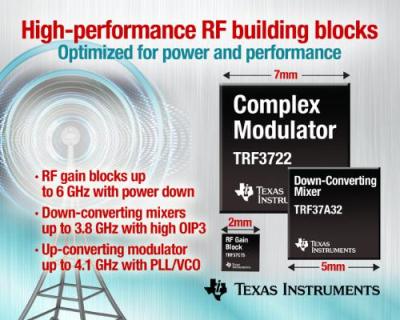Texas Instruments (TI) expanded its RF portfolio today with the addition of high-performance RF gain blocks, down-converting mixers and a complex modulator that provide the industry's best combination of power and performance.
 Texas Instruments (TI) (NASDAQ: TXN) expanded its RF portfolio today with the addition of high-performance RF gain blocks, down-converting mixers and a complex modulator that provide the industry's best combination of power and performance. For more information about the new RF gain blocks, down-converting mixers and complex modulator, visit www.ti.com/rfgainblocks-pr, www.ti.com/downconvertingmixers-pr and www.ti.com/complexmodulator-pr. (PRNewsFoto/Texas Instruments)
Texas Instruments (TI) (NASDAQ: TXN) expanded its RF portfolio today with the addition of high-performance RF gain blocks, down-converting mixers and a complex modulator that provide the industry's best combination of power and performance. For more information about the new RF gain blocks, down-converting mixers and complex modulator, visit www.ti.com/rfgainblocks-pr, www.ti.com/downconvertingmixers-pr and www.ti.com/complexmodulator-pr. (PRNewsFoto/Texas Instruments)
The new RF devices are being demonstrated this week in TI's booth (#2041) at the International Microwave Symposium and complement TI's existing portfolio of transmit digital-to-analog converters (DACs), receive analog-to-digital converters (ADCs), IQ modulators, IF DVGAs, phase-locked loop (PLL) and RF synthesizers.
RF gain blocks
The new 3.3-V and 5-V RF gain block family offers a unique combination of broad frequency range, small footprint, high integration, high output 3rd intercept point (OIP3) and low power consumption to maximize design flexibility. The versatile devices can be used in many industrial, communications and defense applications, such as smart meters, test and measurement, wireless base stations, RF backhaul, repeaters, and phased-array radar.
Key features and benefits
- Broad frequency range: Broadband matched across a wide operational range of 1 MHz to 6 GHz enables system designers to use the same gain block at RF and IF frequencies.
- Small package, high integration for reduced footprint and bill of material costs:
- 2-mm by 2-mm QFN package saves board space
- Integrated power down eliminates need for an external switch, which reduces bill of materials cost and saves board space.
- High linearity: Provides 10-dB higher OIP3 than comparable 3.3-V RF gain blocks with an integrated power down, enabling the devices to be used in a wide variety of application circuits.
- Low power consumption: 3.3-V gain blocks use only 180 mW of power and the 5-V devices use 400 mW to increase efficiency.
- Pin-compatible: 3.3-V and 5-V supply options in 12-dB, 15-dB, 18-dB and 20-dB gains.